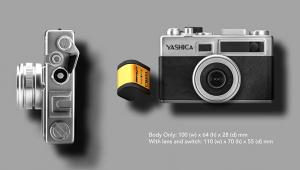What Killed Editorial Sports Photography?: You’ve Got To Hustle As A Sports Shooter These Days

Professional sports photography for the editorial market is an endangered species. Unfortunately, a lot of it has to do with editorial clients turning away from the professional photographer to sports enthusiasts who are willing to trade their photos for season tickets.
And, in large part, it’s a setup that is working for the editorial market. So, if this crowd sourcing of editorial sports photography is killing off the business, what’s next? Where does a photographer trying to earn a living shooting sports go from here?
Let’s talk with our featured photographers for this column and see what they think: Bruce Kluckhohn, Brad Mangin, Bob Martin, Robert Seale, and Michael Zagaris.

Shutterbug: What kinds of sports industry clients have you worked with?
Brad Mangin: For over 20 years my main client as a freelance sports photographer was Sports Illustrated. I earned the bulk of my living by shooting paid assignments for them, keeping my copyright, and earning secondary income from future space rates in the magazine and stock sales through various agencies. That was a viable business model for decades and decades. Not anymore. Those days are long gone and they aren’t coming back. I fought very hard to keep my copyright over the years. I refused to sign bad contracts and I built up my personal online searchable archive (powered by PhotoShelter) with over 83,000 captioned images (including over 6,000 scanned chromes) going back to 1987. I used to think that archive would be a huge part of my retirement. Unfortunately, now it looks like my archive is as valuable as a shoebox full of Joe Charboneau rookie cards.
Robert Seale: Many people make a decent living shooting youth sports leagues, and I’ve seen some shoot action for parents in addition to the usual team and individual portraits. Newspapers and the Associated Press, although suffering, still send some photographers to games, although this market is in danger from the giveaway “wire services.” Eventually editors will decide that a photo from one of those entities, or a handout from the league or network, will be good enough to fill their news sites. Another possibility is to work for an individual team, or league, although these are very sought-after positions, and usually just freelance situations. Most universities have staff photographers, and most of those cover sports regularly. In the advertising world, photographers are usually hired for their individual style or vision, and there are plenty of sports/fitness specialists to choose from. Jobs are awarded to a wide range of people, some who have no experience in sports. Most people who do sports/fitness work have portrait lighting skills, and do other genres of work as well.

Bruce Kluckhohn: My primary clients have been the teams (Minnesota Wild, Minnesota Twins, and Minnesota Timberwolves) and the leagues, wire services, and magazines, with a little of sports paraphernalia, too. These have been direct client as well as a little bit of work from ad agencies. I think the best clients are still difficult to find but ad agencies usually have more appreciation for strong work and understand budgets. Some direct clients are great, but many want what is good enough not necessarily what is best.
Michael Zagaris: I have worked for the San Francisco 49ers since 1973 and the Oakland A’s since 1981. As far as editorial clients go, I have worked with Sports Illustrated, Sport magazine, Inside Sports magazine, Sporting News magazine, Topps and Upper Deck baseball cards companies. My images have appeared in numerous baseball and football photography books—all produced by different publishers.
Bob Martin: Based in a suburb of London, England, I come from an editorial background—magazines and newspapers, particularly Sports Illustrated stories in Europe. I still do some work for them, much less than I used to. Back then I was very proud and pleased to be part of the value placed on still photography and based on healthy budgets. Today those budgets and assignment day rates do not exist. In those early days they even had writers based in Europe. Luckily I had other clients developing at the same time and I have always done a bit of commercial photography.

SB: What are the most pressing industry changes you have seen in the editorial sports photography market?
Brad Mangin: It’s very simple. There are not many clients left who will pay for working photographers to create original content at a ballgame of any kind. The market is flooded with free or cheap wire pictures that are good enough for most end users. The ride is over. It was fun while it lasted.
Michael Zagaris: It has been going on for some time but this “corporatization” of the sports industry has been accelerated because now corporations are in control and it is only big business and big money to them. What I have found with big money is that they want it all for themselves and very little for others. When money controls decisions it means more money for the few at the top and less and less for everyone else. So you have little—if any—upward mobility. This reflects much of what is also happening in the United States economy and world economy in general. It feels to me increasingly more corrupt. When you put money and profits ahead of people, we are really screwed.
I am working now with Getty who distributes my sports images. Photographers cannot distribute their own sports images because they must have a license to distribute from the sports leagues. To remain competitive, Getty feels they have to make these side deals that give their clients access to our photos for next to nothing. For instance, photos that used to go for $250 for a quarter page now may garner $5 for the same space with the photographer splitting that $5 with Getty.

Bruce Kluckhohn: One of the big changes is in distribution of the images. The agencies that feed the news services have made deals with their clients that are based on volume and the photographers have no control over the pricing on sales. The portion of sales that goes to individual photographers has greatly diminished. There are more sales, but they are for $5 of which we get half. I always hope these are sales for cell phone use only in Baltimore for an hour to justify such a low sale, but I really have no idea. I had a photo of Jim Thome that ran 1.5 pages in Sports Illustrated just after they made a deal with Getty that all photos except covers and two-page photos would be $50, so I got $25. A few months earlier and I would have gotten 10 times that.
Robert Seale: Basically, the deal is, editorial sports photography is completely dead as a market for a photographer to make even a modest living. Dead. Kaput. Over. Flatlined. The best action photographers in the world, who freelanced or were staffers at the major sports magazines, are all out of work and exploring other ways to make a living with their photography—workshops, corporate work, etc.
Bob Martin: I think the decline in editorial sports photography is far more in the States than in Europe. It’s a shame the way it is, but we have to evolve and change—we can’t become dinosaurs. The difference between today and 10 years ago: then you were asked to shoot an image based on your style and today your assignment is a fixed concept or based on a green screen and Photoshop. Fifteen years ago, my syndicated picture sales were 30 percent of my yearly income and 50 percent were editorial commissions and 20 percent were commercial shoots. Now, only 5 percent is stock photo sales, 15 percent is editorial photography, and 40 percent is now commercial or sponsor-supported photography—so I am either working for a sponsor or the event organizer. Advertising photography is still 10 percent, and the balance would be consulting fees.

SB: What have been the most effective ways to market your sports photography, what works best for you?
Michael Zagaris: It is very difficult because the money from editorial work isn’t there as a living wage any longer. We are much like artists in that we better be passionate about what we do because we are not going to get rich. Doing this now, you are lucky if you can make a middle-class living. To get started, I would recommend you start with an internship or apprenticeship with someone very well established. The sports industry now is a lot like Hollywood where you have to know someone, make personal connections, have the equivalent of a “SAG card,” and work your butt off to even get in the door.
What works best for me is owning my own images (that doesn’t happen anymore) and cultivating the total access I used to have (that also doesn’t happen much anymore). As far as marketing my images, most clients have to come directly to me—and some are not always very happy about it. It is “old school” for many of today’s sports clients because I am in control of my work and of my pricing, not some mega-profitable corporate entity.

Bob Martin: I have tried lots of different things—mailers, advertising—everything really. The only real return on investment has been my website. I would recommend photographers spend as much money as they can on a smart, simple website that is slick and refined. The other thing you must do is be available on the phone, answer e-mails fast and quick. In this business you have to do the thing that is so difficult: be in touch with clients and concentrate on the photography at hand at the same time. I am in the process of doing another bit of promotion, a retrospective book of my photography—an old-fashioned coffee-table book due out in November 2015. The book is called 1/1000th (www.1-1000th.com).
Robert Seale: How do I operate these days? Although I have many years of experience shooting games and big sporting events, I basically gave up that part of my career in 2006 or so. I still shoot sports portraits for magazines, and I get to do sports-oriented commercial work occasionally, but I’ve made it my mission to have many irons in the fire in different areas other than sports.
Bruce Kluckhohn: Honestly, it has usually been word of mouth. I have done direct mail, and there has been a little response to that, but usually it is just to remind existing clients that I am around. For many of the sports clients, you can see what their publications use. Teams and magazines have their issues as well as online use. For sports manufacturing, Google can help with the ad agencies that represent them. I have long wondered which is better: going for clients who appreciate work or trying to lure ones who have not used it well. I have had a little luck both ways, and like most photographers, not much luck either way as well.

Brad Mangin: I try very hard to get my name out there with social media. I embraced Instagram early on, and even published a book in 2013, Instant Baseball: The Baseball Instagrams of Brad Mangin, with my iPhone baseball pictures sent out over my Instagram feed @bmangin. I also blog all the time about the games I shoot to improve my SEO (Search Engine Optimization) and to show people what I am shooting lately. I have really good SEO thanks to some really smart friends who helped me many years ago, so I need to work hard to maintain that. I also have a wonderful website with big, beautiful photographs powered by PhotoShelter that I update regularly.


Resources
Bruce Kluckhohn: brucekphoto.com
Brad Mangin: manginphotography.com
Bob Martin, Luminanza LLP: bobmartin.com
Robert Seale: robertseale.com
Michael Zagaris: zagaris.photoshelter.com
















































